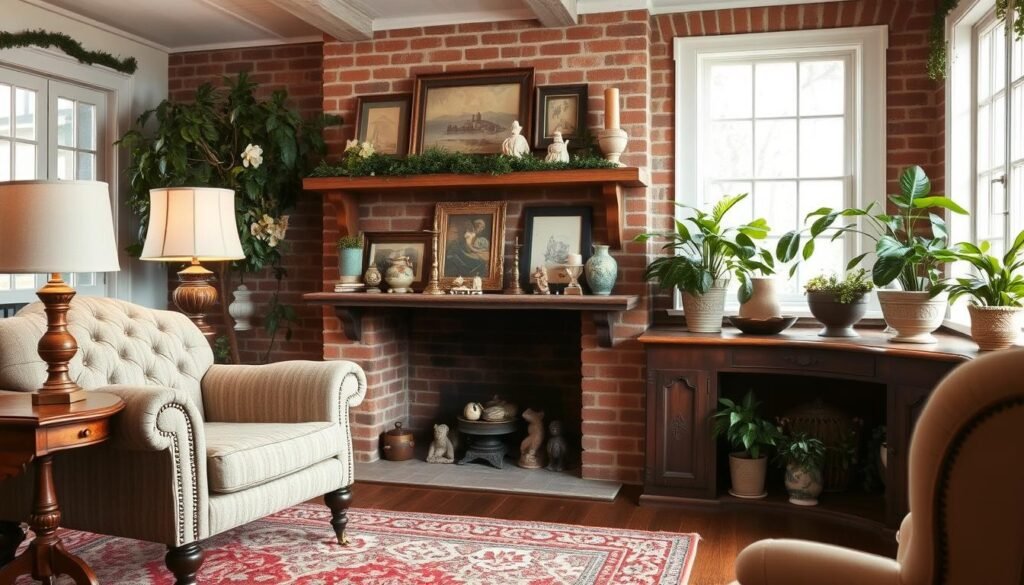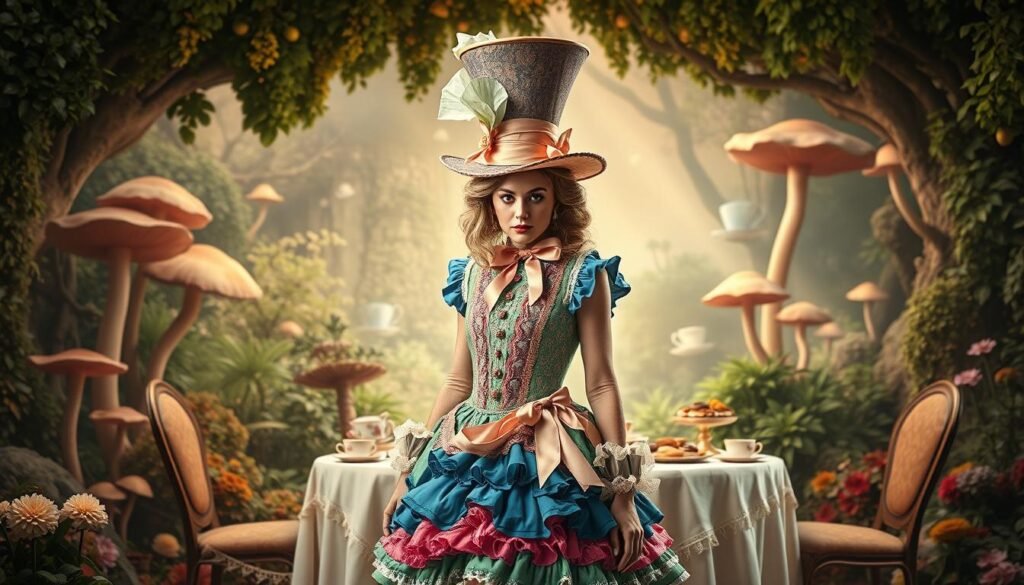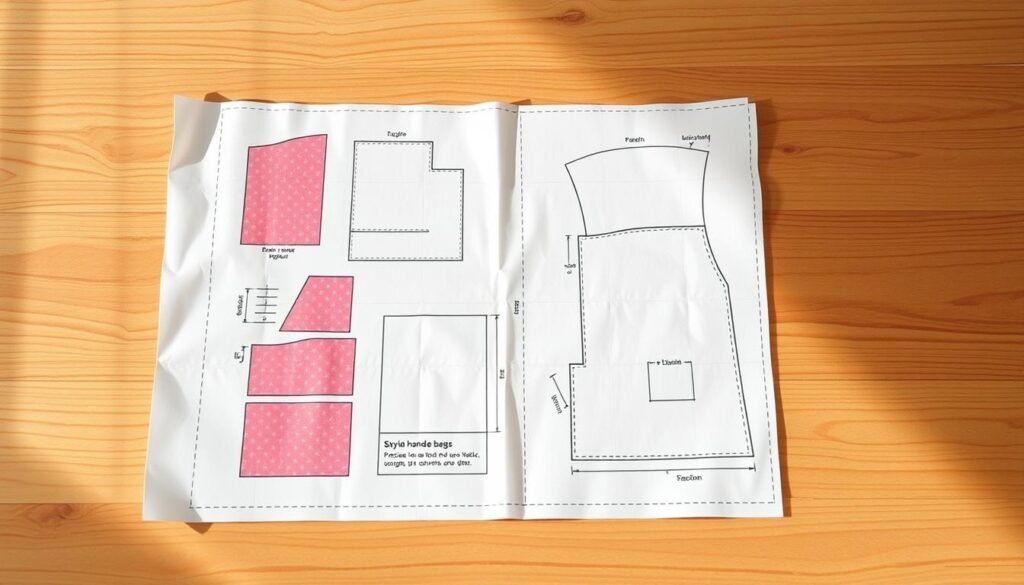Imagine walking into a room that whispers stories through every carefully chosen detail. That’s the magic of blending timeless charm with modern living – creating spaces that feel both familiar and excitingly fresh. Whether you’re drawn to mid-century curves or rustic farmhouse textures, these aesthetic choices become extensions of your personal narrative.
You don’t need to be an expert to craft rooms with soul. The secret lies in mixing authentic finds with contemporary comforts. We’ll show you how to spot quality craftsmanship (hint: look for dovetail joints and solid wood grains) and why that 1970s lamp might be your new favorite conversation starter.
What makes this approach special? It’s sustainable self-expression. By giving pre-loved items new life, you create interiors that feel collected rather than copied. Plus, you’ll develop an eye for pieces that appreciate in character – if not always in monetary value.
Ready to transform your space without overspending? We’ll share practical tips for sourcing treasures at flea markets and online marketplaces. From assessing condition to styling mismatched furniture, you’ll gain confidence to make choices that reflect your unique taste while honoring design heritage.
Introduction to Timeless Vintage Home Decor
Environments shaped by history hold a special kind of magic. Think of furnishings that witnessed decades of life – their scratches and patinas adding depth to your space. These treasures bridge generations, offering designs that modern factories can’t replicate.
What Makes Pieces Stand the Test of Time
True era-specific items (20-100 years old) showcase telltale signs of their origins. Look for hand-carved details, irregular wood grains, or slight asymmetries – marks of human craftsmanship. Unlike reproductions, original pieces develop richer character as they age.
| Aspect | Authentic Finds | Modern Copies |
|---|---|---|
| Age | Visible wear patterns | Uniform surfaces |
| Materials | Solid wood/metal | Composite blends |
| Details | Hand-finished edges | Machine-perfect lines |
| Value | Grows with story | Depreciates quickly |
The Power of Curated Mixes
Eclectic combinations work because they share quality-first principles. A 1960s ceramic lamp pairs with 1980s woven chairs when both prioritize durable materials. This approach reduces waste – you’re rescuing well-made items rather than buying new.
Emotional resonance matters too. That mid-century armchair? It sparks conversations about design evolution. Mass-produced alternatives simply can’t match that depth. Your space becomes a living museum of craftsmanship.
The History and Evolution of Vintage Style
Design movements don’t just fade—they leave fingerprints on our spaces. The ornate carvings of Victorian furniture tell tales of craftsmanship before assembly lines. Mid-century modern’s sleek legs? A rebellion against postwar austerity. Each era’s aesthetic choices reflect its cultural heartbeat.
The Industrial Revolution changed everything. Factories could suddenly mass-produce decorative elements once reserved for aristocracy. This shift birthed democratized elegance—think pressed glass vases and stamped metal accents. Quality didn’t disappear; it evolved.
Post-1950s prosperity brought experimentation. Designers mixed materials like teak and fiberglass, creating pieces that balanced function with playfulness. Scandinavian simplicity emerged as a counterpoint to excess, proving less could indeed be more.
| Era | Key Features | Materials |
|---|---|---|
| Victorian | Floral motifs, dark woods | Mahogany, velvet |
| Mid-Century | Geometric shapes | Plywood, chrome |
| Scandinavian | Clean lines | Light oak, wool |
Regional differences matter too. French Art Nouveau’s swirling ironwork contrasts sharply with American Craftsman’s sturdy oak. Recognizing these roots helps you mix pieces that converse rather than clash.
Why does this history lesson matter? Knowing a chair’s 1930s Bauhaus origins lets you pair it intentionally—maybe with a 1970s macramé wall hanging. You’re not just decorating; you’re curating dialogues across decades.
Embracing “vintage home decor” in Your Space
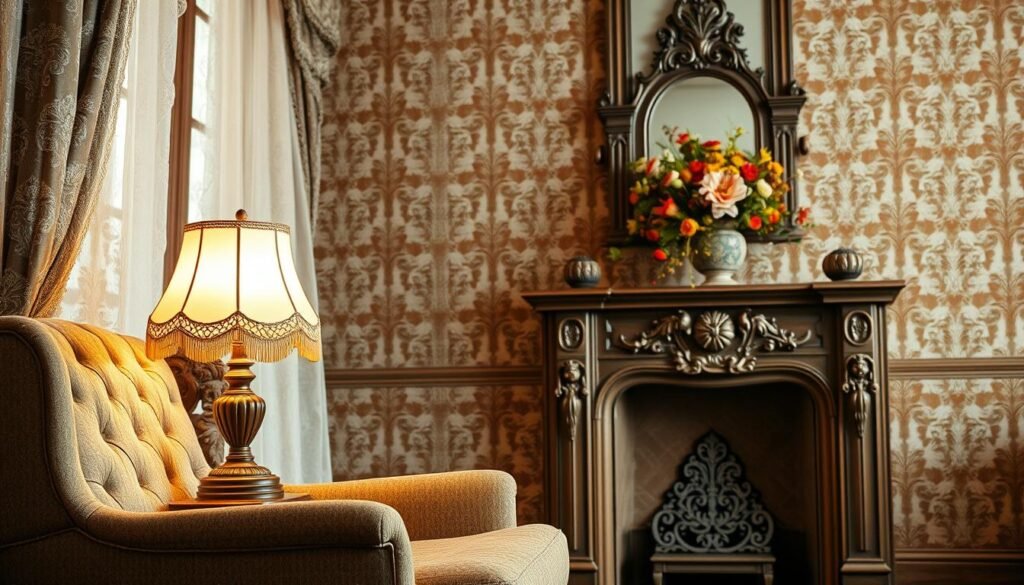
Your rooms become storytellers when you weave historical design DNA into modern layouts. The trick? Knowing which eras speak to you – and how their visual languages translate to today’s needs.
Key Periods and Influences
Four design movements dominate conversation among style enthusiasts:
| Era | Style Characteristics | Signature Motifs |
|---|---|---|
| Art Nouveau | Whiplash curves, asymmetrical shapes | Iris flowers, dragonflies |
| Art Deco | Sunburst patterns, stepped forms | Ziggurats, chevrons |
| Mid-Century | Organic modern silhouettes | Atomic starbursts |
| Victorian | Ornate carvings | Acanthus leaves |
Iconic Styles and Motifs
Mix geometric Deco accents with floral Nouveau textiles for dynamic contrast. Try pairing a 1950s kidney-shaped coffee table with curved 1920s armchairs – their shared organic forms create harmony.
Lighting bridges eras beautifully. A Tiffany-style lamp (inspired by 1900s designs) casts flattering light on 1970s macramé wall art. Both pieces celebrate craftsmanship through different decades.
Remember: successful blending needs one unifying element. Maybe it’s wood tones across all pieces, or a recurring color in upholstery. This thread helps eclectic mixes feel intentional rather than chaotic.
Spotlight on Art Deco and Vintage-Inspired Pieces
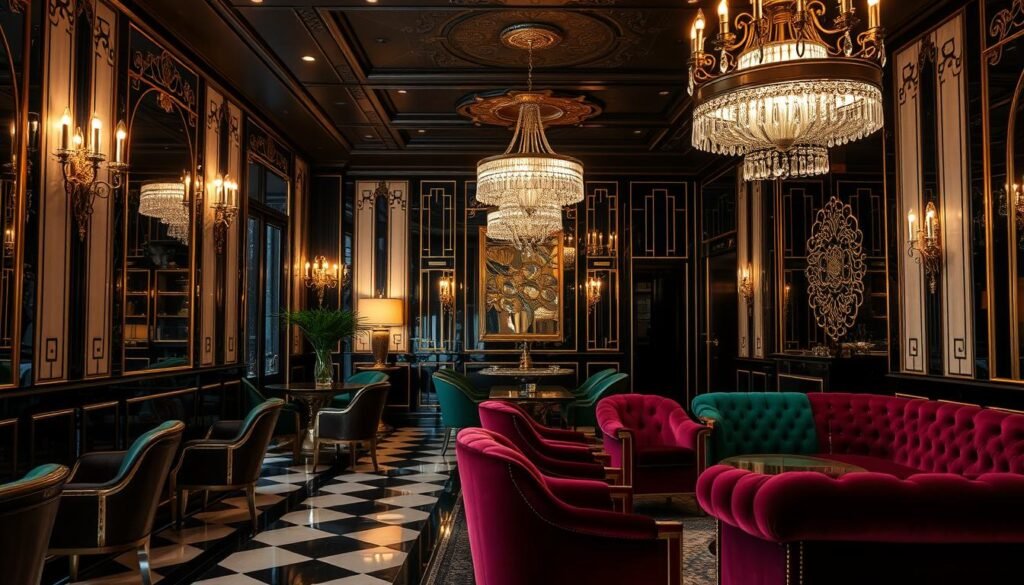
Step into a space where geometry meets glamour – that’s the essence of Art Deco’s enduring appeal. This 1920s-born style brings architectural drama to everyday living through sharp angles and luxurious materials. Modern interpretations let you capture its spirit without museum-like formality.
Art Deco Elements in Modern Homes
Start with sunburst mirrors or zigzag-patterned rugs – instant focal points that command attention. Metallic finishes in gold or chrome add subtle opulence, while stepped forms (think tiered side tables) create visual rhythm. Brands like Magnolia blend these signatures with contemporary needs – their Deco-inspired mirror collection meets modern safety standards while preserving vintage elegance.
Vintage Aesthetic Details
Balance bold Deco statements with softer touches. Pair geometric lamps with curved velvet chairs, or layer chevron pillows on a neutral sofa. Quality matters most – look for solid wood frames or hand-polished metals that echo the era’s craftsmanship.
Pro tip: Introduce Deco gradually. A single statement chandelier or lacquered tray can transform a room. Mix eras confidently – that 1970s macramé wall hanging? It’s a perfect textural counterpoint to Deco’s sleekness.
Curated Brass and Wood Accents for Your Home
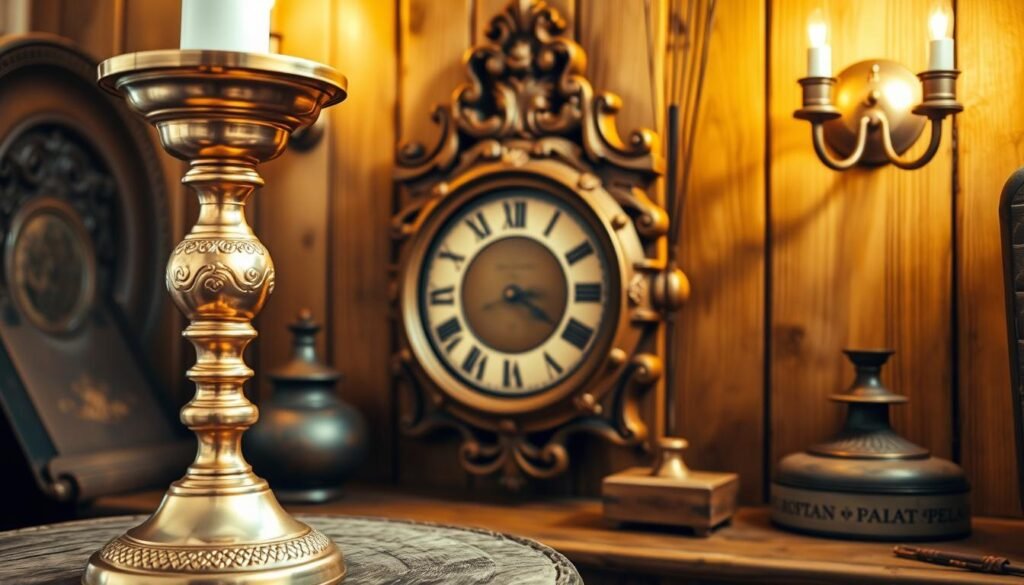
Some materials transform rooms simply by existing – brass and wood work that magic through texture and tone. These elements create focal points that feel intentionally collected, not randomly placed. Let’s explore how to balance their distinct personalities in your space.
Exploring Brass Details
Polished brass adds instant refinement – like Magnolia’s scalloped bowls ($38-$98) catching light near windows. For subtle touches, try their coaster sets ($24) or bud vases ($28). Heirloomed’s candlesticks ($18+) prove you don’t need big budgets for this warmth.
Maintenance matters. Wipe brass monthly with lemon juice and salt to preserve its glow. Let natural tarnish develop in low-traffic areas – that patina tells your decor’s story.
The Warmth of Wood in Decor
Oak wood cutting boards or walnut frames ground brass’s shine beautifully. Heirloomed’s kitchen tools ($32+) show how functional pieces can double as display-worthy accents. Pair them with Magnolia’s apple boxes ($68) for layered texture.
Mix wood tones intentionally. Lighter birch shelves complement dark brass trays, while mahogany side tables harmonize with golden finishes. Always check for dovetail joints and smooth surfaces – signs of lasting craftsmanship.
Together, these materials create spaces that feel lived-in yet polished. A brass keepsake box on an oak dresser? That’s where memories meet modern style.
Reflecting Timeless Style with Vintage Mirrors and Wall Art
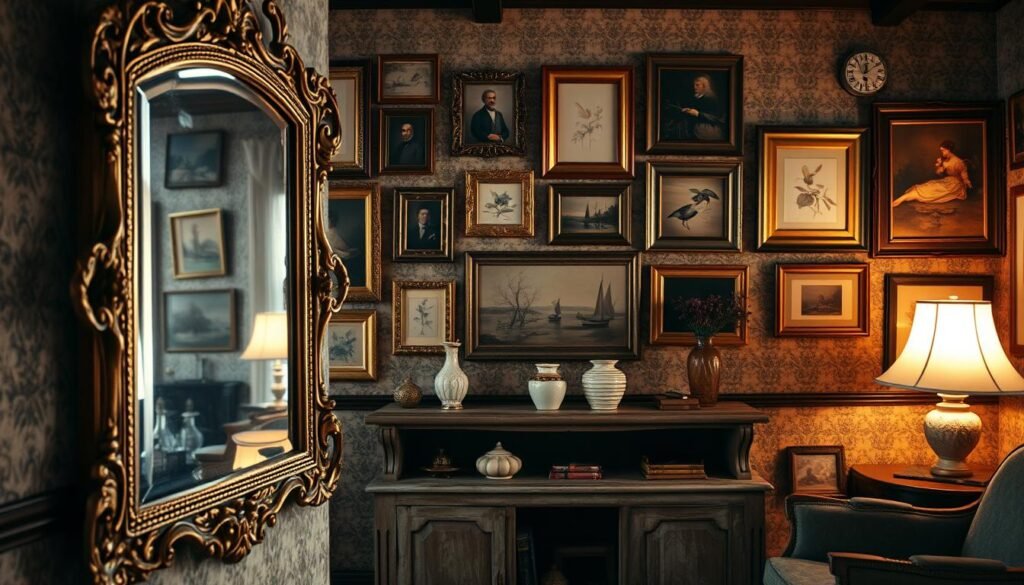
Walls become galleries when you layer pieces that carry history’s whisper. A well-chosen mirror or photograph collection adds depth – both literal and emotional – to your space. Let’s explore how these elements work together to create rooms that feel curated, not cluttered.
Choosing Statement Mirrors
Magnolia’s Arched Antiqued Inez Mirror proves why some pieces sell out repeatedly. Its distressed frame catches light differently each day – morning sun reveals wood grain textures, while evening lamps highlight hand-carved details. For smaller spaces, their geometric designs add architectural interest without overwhelming.
Consider placement carefully. Hang mirrors opposite windows to amplify natural light, or use them as bold focal points above consoles. Pairing multiple styles? Stick to one finish (like brushed brass) for cohesion. Need more interior design tips with antique mirrors? Angle them to reflect your favorite artwork.
Curating Wall Art Collections
Heirloomed’s $15 black-and-white portraits become conversation starters when grouped in threes. Mix sizes intentionally – place a large framed photo beside smaller unframed pieces. Their $45 gallery-ready options save you matting hassle while preserving that sought-after patina.
Create rhythm through repetition. Try matching frame colors across different art styles, or alternate vertical and horizontal layouts. Vintage maps work beautifully beside abstract paintings when tied together by similar earthy tones. Always check for acid-free backing – it protects both art and walls.
Remember: great wall decor tells mini-stories. That $24 assorted artwork collection? Each piece shares tales of past owners. Your job? Arrange them so new chapters emerge every time someone glances their way.
Elegant Tables, Decorative Holders, and Unique Trays
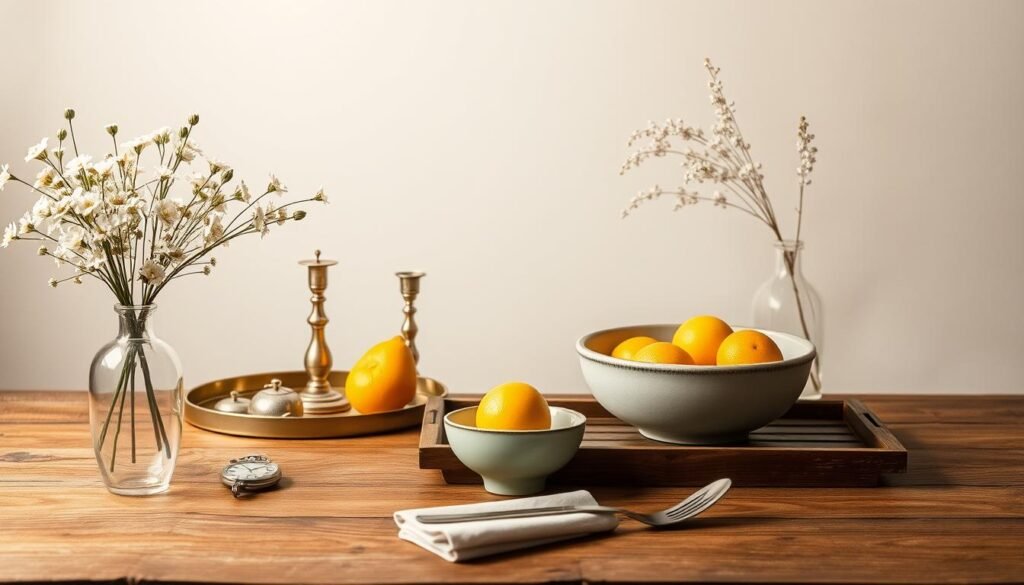
Everyday items become style statements when they balance beauty with purpose. Magnolia’s Ellis Vintage-Inspired Cake Stand with Dome proves this – its glass cloche turns cupcakes into gallery-worthy displays. Pair it with their English Inlay Serving Board for cheese nights that feel like 1920s soirées.
Trays do heavy lifting in stylish spaces. The Floral Antique Brass Tray organizes perfume bottles on dressers by day, then serves cocktails at dusk. Prefer subtle shine? Try the Brass Scallop Tray – its curved edges soften angular coffee tables beautifully.
Holders add personality where you least expect it. Magnolia’s cookbook stand keeps recipes visible while channeling library charm. Their magazine rack? Perfect for displaying art books open to favorite pages. Both pieces prove function fuels form in lived-in spaces.
Mix metals fearlessly – an etched brass tray pops against pewter candle holders. Just maintain one dominant finish (60% of items) for cohesion. That footed tray? Use it beyond dining rooms. Try holding skincare essentials or corralling desk supplies.
Quality shows in details. Check serving boards for tight inlay work – gaps indicate rushed craftsmanship. Test tray handles for smooth edges. These pieces should last through countless gatherings, acquiring character with each use.
Seasonal Trends in Vintage Home Decor
Your space evolves like nature itself when you let seasonal shifts guide your styling choices. Timeless furnishings act as anchors, while subtle swaps in textiles and accents keep rooms feeling current. The secret? Working with your existing collection rather than against it.
Adapting Vintage Pieces Through the Seasons
Neutral-toned furniture and decor provide the perfect canvas for seasonal layers. Swap linen pillow covers for wool knits in winter, or add rattan trays to wood surfaces for summer. Brass candle holders transition seamlessly – fill them with evergreen sprigs in December or dried lavender in June.
| Season | Styling Swap | Material Pairing | Color Palette |
|---|---|---|---|
| Spring | Sheer curtains | Wicker + porcelain | Mint + cream |
| Summer | Jute rugs | Rattan + glass | Terracotta + sage |
| Fall | Velvet throws | Brass + oak | Mustard + charcoal |
| Winter | Faux fur accents | Iron + walnut | Burgundy + gold |
Rotate statement pieces strategically. That ornate planter? Showcase tulips in April, pumpkins in October. Store off-season items in acid-free tissue – their patina will deepen beautifully over time.
Identify your hero pieces that stay year-round, like carved wood cabinets. Then let smaller accents shine seasonally. A depression-era bowl holds citrus in summer and pinecones in winter, telling new stories with each rotation.
Curated Collections: Tapestries, Picture Frames, and Vases
Walls transform into storybooks when layered with pieces that spark curiosity. Magnolia’s collections let you craft rooms that feel both intentional and inviting – think textured tapestries softening blank spaces, frames showcasing cherished memories, and vases adding sculptural charm.
Diverse Options for Every Room
Their oversized Daybreak tapestry brings sunrise hues to living areas, while the best-selling Out of the Woods design adds woodland whimsy. Pair these with European Countryside scenes for a global aesthetic. Frames become gallery walls when mixed – try grouping Heirloomed’s matted black-and-white prints with Magnolia’s distressed wood borders.
Vases balance form and function. Use tall ceramic pieces as bookcase anchors or cluster small bud vases on entry tables. Pro tip: rotate seasonal blooms in the Serene Retreat design – its neutral tones adapt effortlessly.
These collections prove thoughtful curation beats perfect matching. A vintage-inspired landscape tapestry? It dialogues with modern frames when tied through earthy color stories. Your space becomes richer with every layered discovery.

